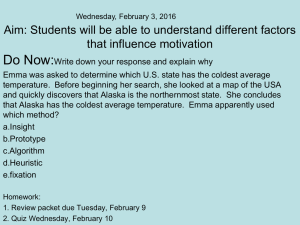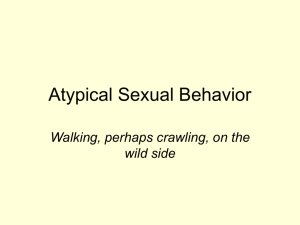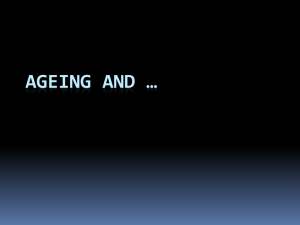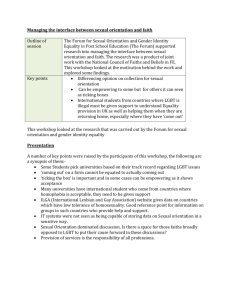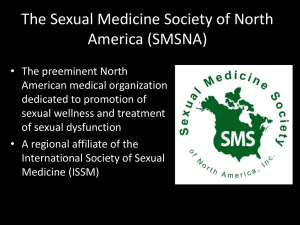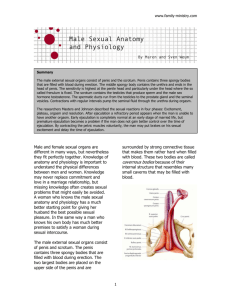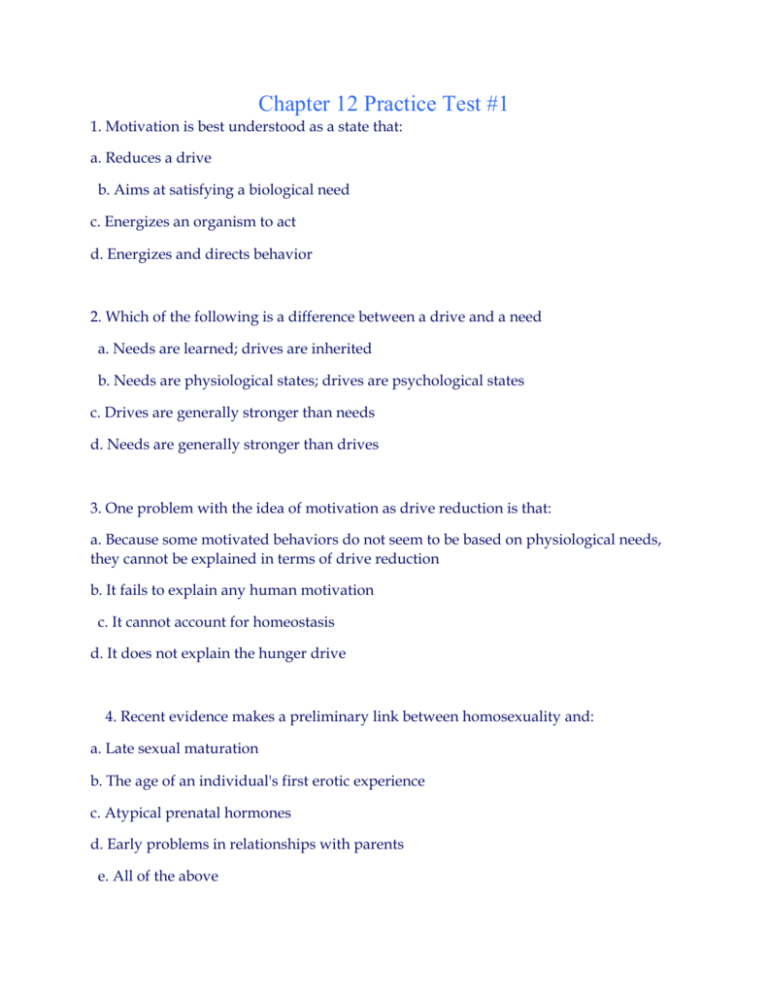
Chapter 12 Practice Test #1
1. Motivation is best understood as a state that:
a. Reduces a drive
b. Aims at satisfying a biological need
c. Energizes an organism to act
d. Energizes and directs behavior
2. Which of the following is a difference between a drive and a need
a. Needs are learned; drives are inherited
b. Needs are physiological states; drives are psychological states
c. Drives are generally stronger than needs
d. Needs are generally stronger than drives
3. One problem with the idea of motivation as drive reduction is that:
a. Because some motivated behaviors do not seem to be based on physiological needs,
they cannot be explained in terms of drive reduction
b. It fails to explain any human motivation
c. It cannot account for homeostasis
d. It does not explain the hunger drive
4. Recent evidence makes a preliminary link between homosexuality and:
a. Late sexual maturation
b. The age of an individual's first erotic experience
c. Atypical prenatal hormones
d. Early problems in relationships with parents
e. All of the above
5. Increase in insulin will:
a. Lower blood sugar and trigger hungry
b. Raise blood sugar and trigger hunger
c. Lower blood sugar and trigger satiety
d. Raise blood sugar and trigger satiety
6. Electrical stimulation of the lateral hypothalamus will case an animal to
a. Begin eating
b. Stop eating
c. Become obese
d. Begin copulating
e. Stop copulating
7. The text suggests that a neophobia for unfamiliar tastes:
a. Is more common in children than in adults
b. Protected our ancestors from potentially toxic substances
c. May be an early warning sign of an eating disorder
d. Only grows stronger with repeated exposure to those tastes
e. Does all of the above
8. Rodin found that, in response to the sight and smell of a steak being grilled:
a. Overweight people had a greater insulin response than people of normal weight
b. People of normal weight has a greater insulin response than overweight people
c. Externals had a greater insulin response than internals
d. Internals had a greater insulin response than externals
9. Instinct theory and drive-reduction theory both emphasize _____ factors in
motivation
a. Environmental
b. Cognitive
c. Psychological
d. Social
e. Biological
10. The correct order of the stages of Masters and Johnson's sexual response cycle is:
a. plateau; excitement; orgasm; resolution
b. excitement; plateau; orgasm; resolution
c. excitement; orgasm; resolution; refractory
d. plateau; excitement; orgasm; refractory
e. excitement; orgasm; plateau; resolution
11. Few human behaviors are sufficiently automatic to quality as:
a. needs
b. drives
c. instincts
d. incentives
12. Theory ________ managers tend to adopt a style of ________ leadership.
a. X; task
b. X; social
c. Y; autocratic
d. Y; directive
13. In his study of men on a semistarvation diet, Keys found that:
a. the metabolic rate of the subjects increased
b. the subjects eventually lost interest in food
c. the subjects became obsessed with food
d. the subjects' behavior directly contradicted predictions made by Maslow's hierarchy
of needs.
14. When asked what makes life meaningful, most people first mention:
a. good health
b. challenging work
c. satisfying relationships
d. serving others
15. Bulimia nervosa involves:
a. binging
b. purging
c. dramatic weight loss
d. a and b
e. a, b, and c
16. Castration of male rats results in:
a. reduced testosterone and sexual interest
b. reduced testosterone, but no change in sexual interest
c. reduced estrogen and sexual interest
d. reduced estrogen, but no change in sexual interest
17. (Close-up) Which of the following has been found to be most effective in treating
sexual disorders?
a. psychoanalysis
b. cognitive therapy
c. drug therapy
d. behavior therapy
18. It has been said that the body's major sex organ is the brain. With the regard to sex
education:
a. transmission of value-free information about the wide range of sexual behaviors
should be the primary focus of the educator
b. transmission of technical knowledge about the biological act should be the
classroom focus, free from personal values and attitudes of researchers, teachers, and
students.
c. the home, not the school, should be the focus of all the instruction about
reproductive behavior
d. people's attitudes, values, and morals cannot be separated from the biological aspects
of sexuality
19. Kinsey's studies of sexual behavior showed that:
a. males enjoy sex more than females
b. females enjoy sex more than males
c. premarital sex is less common than is popularly believed
d. sexual behavior is enormously varied
20. To increase employee productivity, individual/organizational psychologists advise
managers to:
a. adopt a directive leadership style
b. adopt a democratic leadership style
c. instill competitiveness in each employee
d. deal with employees according to their individual motives
ANSWERS
1. D
2. B
3. A
4. C
5. A
6. A
7. B
8. C
9. E
10. B
11. C
12. A
13. C
14. C
15. D
16. A
19. D
17. D
20. D
18. D

